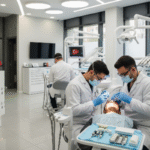
Facelift procedures are no longer just for women. Over the past decade, a growing number of men have turned to cosmetic surgery to rejuvenate their appearance and stay competitive both socially and professionally. The increasing popularity of male facelifts represents a broader trend in the world of male aesthetic procedures, where terms like Brad Pitt facelift, facelift before and after, and eyelid surgery are no longer gendered searches. Whether driven by Hollywood icons or the desire for self-improvement, men are embracing cosmetic procedures more than ever.
Why Are More Men Getting Facelifts?
What’s behind the rising trend of male facelifts?
The motivations behind this increase are varied. Some men want to maintain a youthful edge in the workplace, where age can subtly impact opportunities. Others are influenced by celebrities—search interest in Brad Pitt facelift and facelift before and after transformations highlights how public figures are shaping beauty ideals.
In today’s visual-driven world of social media and video calls, many men are becoming more aware of their facial aging—sagging skin, deep lines, and loss of jawline definition—and are seeking ways to restore confidence and vitality. The stigma around male cosmetic procedures is also fading, giving way to a new standard where self-care and aesthetic maintenance are celebrated.
How Do Male Facelifts Differ from Female Procedures?
What makes a male facelift different from a female one?
While the core technique of a facelift—tightening sagging facial muscles and removing excess skin—remains consistent, the approach for men is more subtle and tailored to preserve masculine features. Men typically want to maintain a strong, square jawline and avoid the overly tight or “done” look that can sometimes result from aggressive lifting.
Surgeons consider several anatomical differences when performing a male facelift. Men have thicker skin, more vascular facial structures (which increases the risk of bleeding), and different hairlines. Preserving sideburns and ensuring natural-looking incisions are critical.
A skilled surgeon will aim for a discreet enhancement, giving men a fresher, more rested appearance without altering their essential look. Complementary procedures like eyelid surgery and rhinoplasty are often added to refine the result.
What Other Aesthetic Procedures Do Men Combine with a Facelift?
In many cases, a rhytidectomy is part of a more comprehensive aesthetic transformation. Popular companion procedures include:
- Eyelid surgery (blepharoplasty): Removes droopy upper lids or puffy under-eye bags that often accompany facial aging.
- Rhinoplasty: Some men choose to refine the shape of their nose to achieve a more balanced profile.
- Neck lift: Often combined with a facelift to remove loose skin and fat under the chin for a defined jawline.
- Tummy tuck or male version of a mommy makeover: For men looking to rejuvenate their overall appearance, especially after significant weight loss.
These combined treatments offer more harmonious, head-to-toe rejuvenation.
What Are the Results of a Male Facelift Like?
What should men expect from a facelift before and after?
Patients are often searched by potential patients looking for real-world results. Men can expect subtle but noticeable improvements—a more defined jawline, smoother cheeks, and a more youthful overall appearance.
Recovery time is generally one to two weeks, with most men returning to work or normal activities soon after. Full results may take several months to settle, as swelling gradually subsides. Scars are usually hidden around the ears or hairline, and with skilled execution, they’re barely noticeable.
Before committing, many patients consult before and after photos to set realistic expectations. These images also help communicate desired outcomes to their surgeons.
What’s Driving the Normalization of Male Cosmetic Surgery?
Cosmetic surgery is no longer a taboo topic among men. Cultural shifts have made it more acceptable—and even aspirational—for men to invest in their appearance. Fitness culture, social media, and celebrity influence have contributed to this shift. Today, it’s just as common to see men talking about skin care, Botox, or facelifts as it is women.
The visibility of male celebrities who age gracefully—and sometimes surgically—like Brad Pitt has played a role. While there’s no confirmation of a Brad Pitt facelift, the speculation alone indicates how public figures drive aesthetic trends and increase awareness of procedures.
How to Choose the Right Surgeon for a Male Facelift?
What should men look for in a facelift specialist?
Choosing a board-certified plastic surgeon who specializes in male facial anatomy is essential. Look for:
- Extensive experience in male cosmetic surgery.
- A natural, subtle portfolio of facelift before and after photos.
- Strong patient reviews and testimonials.
- Comfort discussing combined procedures like eyelid surgery, rhinoplasty, or even body contouring options like a tummy tuck.
Conclusion
The growing demand for facelifts among men reflects broader shifts in societal norms and the acceptance of male aesthetics. Whether motivated by career pressures, personal confidence, or celebrity influence, men are now more empowered than ever to take control of how they age. With proper guidance, realistic expectations, and a skilled surgeon, a facelift can be a transformative step toward a youthful, refreshed appearance—without sacrificing masculinity.



